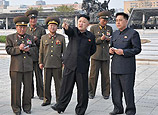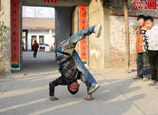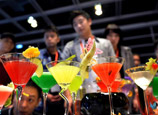
Despite its identity as an imperial palace possessing numerous rare cultural relics in history, Yuanmingyuan is more of a painful historic symbol today compared to other Chinese parallels such as the Forbidden City.
With many of its cultural relics destroyed and lost overseas due to historic reasons, the remnants of the place constitute a small window for people to peer into, imagining its past glory. But they also see its decline and the country's pain.
From April 25 to May 25, a large exhibition of Yuanmingyuan cultural relics is being staged at The China Millennium Monument in Beijing. With 24 different categories of cultural relics including porcelains, bronze wares and jade articles, nine models of pavilions, eight original stone sculptures and replicas of the 12 zodiac animal heads, the exhibition presents a rare opportunity for visitors to have a panoramic view of Yuanmingyuan relics, most of which are on display for the first time.
Historical reminders
If you can't imagine how splendid and magnificent this imperial palace once was, a replica of the letter "Expédition de Chine" by French writer Victor Hugo (1802-85) in one corner of the exhibition hall will give you some clue. "Add up all the treasures of all of our church has arrived on this wonderful, dazzling Oriental Museum, and there is not only art, but also the countless treasures of gold and silver," he wrote in the letter.
"Yuanmingyuan in history functions more like a 'national museum,'" said Zhang Chao, a researcher at Yuanmingyuan, "but since the devastating looting and burning by British and French troops in 1860, and then the serial destructions and theft until and after the break down of the Qing Dynasty (1644-1911), it was finally ravaged to ruins."
At the exhibition, a burnt piece of wood definitely connects visitors to that woeful period of history. With the length of 20 centimeters, the cinereous stick is deformed in shape, but the decorative designs carved onto it are still very clear. In fact, ruined wood relics like this (most of which were from furniture) are plentiful in Yuanmingyuan now, either made of Nanmu or Huanghuali wood, both being high-quality woods.
To underscore its once imperial identity, a group of nine model pavilions at the proportion of 1:25 would help people relate to the historically feudal imperial period. Among the nine models, the Zhengda Guangming Palace looks especially imposing. (The real one in Yuanmingyuan was built by the Yongzheng Emperor in 1725 where he and later emperors dealt with national affairs.)
"In history, both Yongzheng Emperor and Daoguang Emperor spent a greater portion of time in Yuanmingyuan than in the Forbidden City," said Xie Xiuqing, a narrator of Yuanmingyuan, "so we can imagine that those decorations and settings there wouldn't be inferior to those of the Forbidden City."
Digital application
As the application of digital technologies into the protection of cultural relics is becoming increasingly popular, researchers in Yuanmingyuan are also making full use of it. At the exhibition, a huge screen aroused many visitors' interest. When you walk in front of it, scenes of Yuanmingyuan in the past during different seasons will automatically appear, bringing back the once beautiful but unrecoverable sight to people today.
"By restoring those scenes that have disappeared, and combining them with existing ruined relics, we can get a better understanding of history," a visitor with the byline of "Wo'ai Yuanlin" wrote in the visitation logbook at the exhibition hall.
Meanwhile two ruined relics, a gold-decorated bronze Buddha image and an enameled bronze incense holder that were unearthed in the 1980s, also meet the public for the first time, only not in their physical form, but through virtual imagery. Using holographic technology, the two relics are presented in a 360-degree rotation, enabling visitors to see every detail, even the words and thin cracks on them.
With many ruined and others lost, the use of technology makes it possible for the existing relics to meet the public. "We are now engaged in the project of digital Yuanmingyuan, to better serve the protection, research and exhibition of it," Zhang told the Global Times.
The road tour
Adding to the sense of the exhibition, some relics had been shown for a month in Germany's capital Berlin in December last year. It was the maiden foreign trip for those national treasures. And this year, after being exhibited in Beijing, they will go abroad again to Moscow in September.
"Yuanmingyuan is globally known as a Chinese cultural brand. We are planning more foreign exhibitions of this kind in the future to explore new ways of cultural communication and cooperation between China and the world," said Zhang.
While those within the country are starting to make overseas sales, those lost overseas are gradually returning home. The replicas of the 12 zodiac animal heads at the exhibition, appearing in Jackie Chan's CZ12 film last year and now donated by the movie star, reminds people of all those conflicts and subjects in recent years that were raised from the returning of the real artifacts.
The French Pinault family, owner of world leading luxury goods corporation Kering, announced in late April that they will donate the zodiac mouse head and rabbit head to China for free. The surprise move provides a glimmer of hope to many Chinese people who long for the return of other Yuanmingyuan relics.
Among the 12 zodiac animal heads, besides the two that the Pinault family said they will give back to China, five of others including the ox, monkey, tiger, pig and horse heads have been returned by different people buying them overseas and donating them to the Poly Art Museum in Beijing.
Though these are encouraging signs, the returned relics represent only a drop in the massive Yuanmingyuan cultural relic ocean. "Most of the priceless gold, silver, jade and porcelain wares are still kept in foreign museums or private collections," said Zhang.
Maybe when those articles begin to make the journey back, Yuanmingyuan can become a less painful symbol for Chinese people.


















![]()
